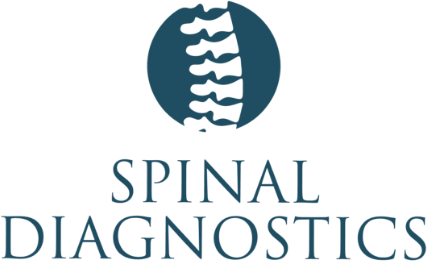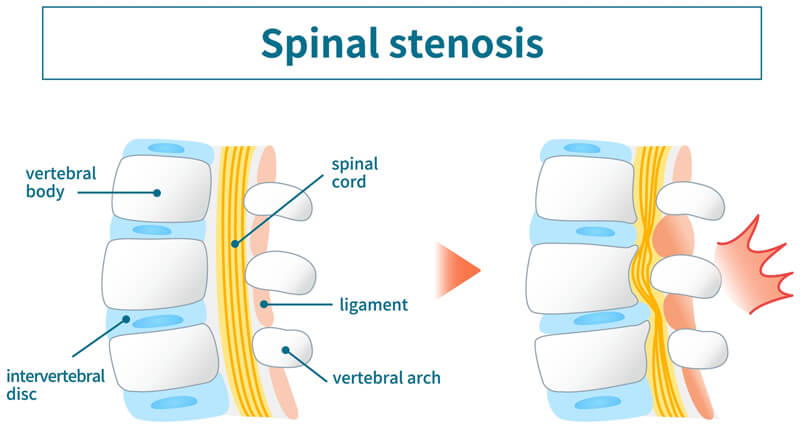Spinal stenosis occurs when there is increased pressure on the spinal nerves due to the narrowed spaces between the bones in the spine. Symptoms that characterize spinal stenosis include pain in the lower back or legs when standing or walking and difficulty with balance and coordination.
Also known as lumbar spinal stenosis, this condition can be caused by spinal injuries, ligament issues, tumors, or correlated degenerative diseases like osteoarthritis. Its development can be significantly influenced by genetics, age, and lifestyle.
Early diagnosis of LSS can prevent the symptoms and spinal condition from worsening. It is usually diagnosed through physical and X-ray examinations.
The lumbar spine is made up of various components. These include the following:
- The vertebrae are the movable structures that hug each intervertebral disc. They are in charge of providing support and protecting the spinal cord.
- The intervertebral discs add flexibility to the lumbar spine. They absorb shock when jumping or walking.
- The spinal cord refers to the nerves located throughout the spinal canal.
- The spinal nerves branch off the spinal cord and innervate different lower body parts.
Some of the characteristic signs of spinal stenosis include the following:
- Leg pain that increases when standing or walking and is alleviated by sitting down or leaning against objects.
- Lower back pain
- Tingling in the back, feet, and legs
- Foot and leg weakness
Spinal stenosis may be caused by multiple factors. These can be related to genetics, trauma, or degenerative changes caused by aging, also known as spondylosis.
As the body ages, the spine can start to develop degenerative changes that can result in the following diseases:
- Bone spurs due to osteoarthritis: Osteoarthritis affects the cartilage between the joints of the lumbar spine. As this disease progresses, bony spurs start to appear, causing a narrowing in the space between the joints.
- Disc degeneration: The intervertebral discs are in charge of adding flexibility to the spine and absorbing shock. When the spine starts to wear down, the space available for the nerves within the spinal cord reduces and causes pain.
- Facet joint hypertrophy: Due to spinal wear down, the facet joints in charge of adding movement start to grow and narrow down the space available for the nerves, increasing pressure and pain.
- Herniated disc due to aging: When an intervertebral disc becomes displaced due to spinal wear down, this is known as a herniated disc. This can cause a narrowing in the spinal nerve canal.
- Thickened ligaments: As the body ages, the ligaments can start to thicken, narrowing the spinal nerve canal.
Congenital factors can play a crucial role in the development of spinal stenosis. This disease can also be caused due to physical trauma:
- Spinal tumors: Genetics can cause the development of tumors in the spinal cord, causing spinal nerve compression.
- Spinal injuries: Physical trauma could warp the spinal structure and thin down the spinal canal. These injuries could also increase the chances of developing a herniated disc. Some of the most common types of spinal injuries occur in the workplace or due to motor vehicle accidents.
In order to diagnose spinal stenosis, a health specialist must identify any congenital factors that could be contributing to the disease's development. Determining genetic factors may lead to early diagnosis and prompt treatment, therefore, avoiding complications.
Then, a physical examination will be done for your lower back area, neck, and legs to identify any potential issues. If no anomalies are recognized with the physical inspection, your doctor will continue with imaging studies like X-rays, MRIs, and CT scans of your lower back area.
After examining your evaluations, your doctor will provide you with a diagnosis and treatment plan tailored to your specific needs.
Depending on your case and the extent of your spinal damage, your treatment may include one or more of the following options:
There are specific physical therapies tailored for patients dealing with spinal stenosis. These exercises can help stretch the lumbar area and increase mobility range, reducing pain and nerve pressure.
Also, lifestyle modifications can play a crucial role in alleviating the symptoms of spinal stenosis. These may include:
- Exercise: Low-impact exercises like cycling, walking, and swimming can tremendously help to strengthen the muscles around the spine and add flexibility to the lumbar area.
- Weight management: Having excess weight could cause an increase in the pressure applied to the spinal nerves, leading to pain in the back and legs. A balanced diet and healthy lifestyle can help you manage your weight to reduce lumbar stress.
- Posture and ergonomics: If your work includes long periods of sitting, using ergonomic chairs and a good posture can help reduce pressure and pain in your spine.
Over-the-counter and prescription medications offered by your health specialist can help reduce spinal swelling and nerve pressure. Depending on the degree of your symptoms, your healthcare specialist will create a medication plan for you with different dosages and methods of administration.
Steroid injections can help provide quick inflammation reduction and symptom relief. These are injected near the spinal nerve area, transmitting pain signals to the brain. Your doctor will use digital imaging to precisely place the needle into the nerves that are causing discomfort.
As the medication is injected into the epidural space, it will flow all around your spinal cord, allowing the anesthetic to block pain signals. Steroid injections offer longer-lasting relief as compared to local anesthetics.
Pain management procedures use medical techniques based on anesthesiology, rehabilitation, medication, and surgery to help patients alleviate chronic pain. Some of the techniques used in this branch of medication may include the following options:
Neuromodulation is the medical technique of altering nerve activity using electrical stimulation. Its objective is to block the pain signals sent into the brain. These can help reduce the lumbar stress caused by spinal stenosis.
Spinal cord stimulation, for example, is a treatment that uses electrical impulses to modify the nerve activity in the spine. As the nerve signals become blocked by this stimulation, the pain won’t be felt even though the symptom source remains.
Minimally invasive interventions are outpatient techniques that help relieve pressure on the spinal cord caused by spinal stenosis. They are a great alternative to surgical procedures since they correct mobility and alleviate pain symptoms without stitches, long recovery time, or general anesthesia.
Some of the best minimally invasive interventions to treat spinal stenosis include:
- MILD procedure: MILD® (minimally invasive lumbar decompression) uses X-ray guidance to insert a special needle in the lower back area. Using a radiofrequency device, your doctor will remove the bone and ligament excess in your spine, allowing it to release pressure and pain.
- Vertiflex (interspinous spacers): Using a small tube inserted into the spine, these interspinous spacers are placed between the vertebrae spaces. These spacers help keep the vertebrae in place and reduce the nerve pressure caused by spinal stenosis.
People who undergo these minimally invasive interventions experience significant pain relief and mobility improvement within a few days. As the name suggests, there is minimal disruption of spinal nerves, enormously reducing procedure-related complications and leading to short healing periods.
Surgical intervention may be suggested when the previously stated treatment options do not completely eliminate spinal stenosis symptoms. Some surgical treatment options include:
- Decompressive laminectomy partially removes the lamina (the arch in the vertebra) to release pressure and reduce pain.
- Spinal fusion removes an intervertebral disc and replaces it with an external bone graft to provide stability to the spine.
- Interspinous process devices are inserted into the vertebra, allowing more space to be built between the spinal bones.






